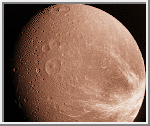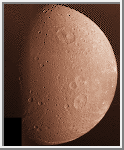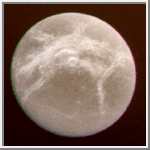 Dione
Dione
Saturn IV
Dione [dy-OH-nee] was discovered in 1684 by Giovanni Cassini.
It is an icy body similar to
Tethys and Rhea.
Its density is 1.43 gm/cm3, which makes it the densest moon
of Saturn other than Titan. Dione is
probably composed of a rocky core making up one-third of the moon's
mass, with the rest water-ice. Its ice coverage is less than that of
Tethys and Rhea.
Dione's icy surface includes heavily cratered terrain, moderately
cratered plains, lightly cratered plains, and whispy material.
The heavily cratered terrain has
numerous craters greater than 100 kilometers in diameter. The plains
area tends to have craters less than 30 kilometers in diameter.
Some of the plains are heavily cratered while others are not.
Much of the heavily cratered terrain is located on the
trailing hemisphere, with
the less cratered plains area existing on the
leading hemisphere.
This is opposite from what some scientists expected. Shoemaker and
Wolfe proposed a cratering model for a tidally locked satellite
with the highest cratering rates on the leading hemisphere
and the lowest on the trailing hemisphere. This suggests that
during the period of heavy bombardment, Dione was tidally
locked to Saturn in the opposite orientation.
Because Dione is relatively small, an impact causing
a 35 kilometer (21 mile) crater could have spun the satellite.
Since there are many craters larger than 35 kilometers (21 miles),
Dione could have been repeatedly spun.
Dione has probably been tidally locked in its current position
for the past several billion years. This is reflected in the
average surface albedo
of the leading and trailing hemispheres.
The surface albedo decreases from the leading to the trailing
hemispheres due to a higher micrometeor dusting on the leading
hemisphere.
The origin of the bright whispy material is somewhat obscure.
Apparently, it is material with a high albedo and is
thin enough that it doesn't obscure the surface feature underneath.
It might have formed from eruptions along cracks in
Dione's surface that fell back to the surface as snow or ash.
| Dione Statistics
|
|---|
|
|
|---|
| Discovered by | Giovanni Domenico Cassini
|
|---|
| Date of discovery | 1684
|
|---|
|
|
|---|
| Mass (kg) | 1.05e+21
|
|---|
| Mass (Earth = 1) | 1.7570e-04
|
|---|
| Equatorial radius (km) | 560
|
|---|
| Equatorial radius (Earth = 1) | 8.7802e-02
|
|---|
| Mean density (gm/cm^3) | 1.43
|
|---|
|
|
|---|
| Mean distance from Saturn (km) | 377,400
|
|---|
| Rotational period (days) | 2.736915
|
|---|
| Orbital period (days) | 2.736915
|
|---|
| Mean orbital velocity (km/sec) | 10.03
|
|---|
|
|
|---|
| Orbital eccentricity | 0.0022
|
|---|
| Orbital inclination (degrees) | 0.02
|
|---|
|
|
|---|
| Escape velocity (km/sec) | 0.500
|
|---|
| Surface gravity (m/sec^2) | 0.223
|
|---|
|
|
|---|
| Visual geometric albedo | 0.7
|
|---|
| Magnitude (Vo) | 10.4
|
|---|
| Mean surface temperature | -186.56°C
|
|---|
 Dione
Dione
This image of Dione is a mosaic of several of the highest resolution
images taken by the Voyager spacecraft. It shows a heavily cratered
surface. The large crater named Aeneas, towards the top
of this image, is 150 kilometers (90 miles) in diameter.
Another large crater named Dido, towards the bottom, is
125 kilometers (75 miles) in diameter.
Bright streaks are found on the opposite side of Dione. A rimmed and
flat floored fracture near the terminator is named Latium Chasma.
It is greater than 300 kilometers (180 miles) long, less than
1 kilometer (.6 miles) deep and 8 to 12 kilometers (4.8 to 7.2 miles) wide.
(Credit: Calvin J. Hamilton)
 Color Composite
Color Composite
This image is a color composite of Dione taken by
Voyager 1 on November 12, 1980.
It was constructed from three
separate images taken through orange, green and blue filters.
It shows a low resolution view of the trailing hemisphere of Dione.
The wispy white streaks are perhaps deposits of snow exuded from
fractures in its crust.
(Credit: Calvin J. Hamilton)
 Wispy White Streaks
Wispy White Streaks
This image of Dione was taken by
Voyager 1 on November 12, 1980.
It shows the Saturn-facing hemisphere. The darker trailing hemisphere
is located toward the right limb, with whispy white streaks
crisscrossing the surface. The plains terrain is located along
the terminator.
(Credit: Calvin J. Hamilton)
Boyce, J. M. and J. B. Plescia. "Crater densities and geological
histories of Rhea, Dione, Mimas and Tethys." Nature,
295, 285-289, 1982.
Moore, Jeffrey M. "The Tectonic and Volcanic History of
Dione." ICARUS, 59, 205-220, 1984.
Plescia, J. B. "The Geology of Dione." ICARUS,
56, 255-277, 1983.
Soderblom, Laurence A. and Torrence V. Johnson. "The Moons of Saturn."
Scientific American, January 1982.

 Saturn
Saturn
 Telesto & Calypso
Telesto & Calypso
 Helene
Helene

Copyright © 1997 by Calvin J. Hamilton.
All rights reserved.
 Dione
Dione
 Color Composite
Color Composite
 Wispy White Streaks
Wispy White Streaks

 Saturn
Saturn Telesto & Calypso
Telesto & Calypso Helene
Helene